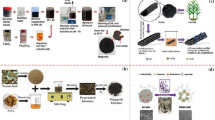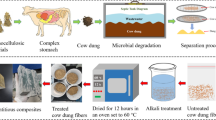Abstract
The current work aims at the preparation and characterization of novel composite materials of acrylic acid/charcoal/montmorillonite (MMT) (PAACM and AMC). They are characterized using SEM, EDX, and TGA. The work handled the removal of cesium and strontium ions, as a model radioactive waste, their concentrations were determined using ICP. The experimental results showed that PAACM composite has a sorption capacity of 11.49 mg/g for Cs+ and 10.99 mg/g for Sr2+, but for AMC, the composite has a sorption capacity of 21.59 mg/g Cs+ and 26.68 mg/g for Sr2+. High thermal stability even at 700 °C the net weight loss is 1% for both composites.









Similar content being viewed by others
References
Mauerhofer E, Havenith A, Kettler J (2016) Prompt gamma neutron activation analysis of a 200 L steel drum homogeneously filled with concrete. J Radioanal Nucl Chem 309(1):273–278
(2003) Remediation of areas contaminated by past activities and accidents. International Atomic Energy Agency, Vienna
(2010) Estimation of global inventories of radioactive waste and other radioactive materials. International Atomic Energy Agency, Vienna
Rahman R, Ibrahium HA, Hung Y-T (2011) Liquid radioactive wastes treatment: a review. Water 3(2):551–565
Shakir K et al (2011) Simultaneous removal of chromotrope 2B and radionuclides from mixed radioactive process wastewater using organo-bentonite. Eur J Chem 2(1):83–93
Geleel MA, Mahmoud NS (2011) Improvement of radioactive waste solidification process using modified bentonite materials. In: Proceedings of the eighth Nuclear and Particle Physics Conference (NUPPAC-2011). Egypt, p. 287
Aliende Urtasun A, Luquin A, Garrido JJ (2017) Nuclear fission technology in Spain: history and social concerns. Public Underst Sci. 26(3):307–324
Hosan MI (2017) Radioactive waste classification, management and environment. Eng Int 5(2):53–62
Sinnathamby G, Korkiala-Tanttu L, Forés JG (2014) Interface shear behaviour of tunnel backfill materials in a deep-rock nuclear waste repository in Finland. Soils Found 54(4):777–788
Keith-Roach M et al (2015) Past experience of environmental, health and safety issues in REE mining and processing industries and an evaluation of related EU and international standards and regulations. Final Report of the EuRare Project; Kemakta Konsult AB: Stockholm, Sweden; Geological Survey of Finland: Espoo, Finland
Banerjee D et al (2016) Removal of TcO4 − ions from solution: materials and future outlook. Chem Soc Rev 45(10):2724–2739
Fernandes MM, Scheinost A, Baeyens B (2016) Sorption of trivalent lanthanides and actinides onto montmorillonite: macroscopic, thermodynamic and structural evidence for ternary hydroxo and carbonato surface complexes on multiple sorption sites. Water Res 99:74–82
Cui Y-J (2017) On the hydro-mechanical behaviour of MX80 bentonite-based materials. J Rock Mech Geotech Eng 9(3):565–574
Milodowski AE, Norris S, Alexander WR (2016) Minimal alteration of montmorillonite following long-term interaction with natural alkaline groundwater: implications for geological disposal of radioactive waste. Appl Geochem 66:184–197
Tournassat C et al (2015) Natural and engineered clay barriers, vol 6. Elsevier, Amsterdam
Tutolo BM et al (2015) CO2 sequestration in feldspar-rich sandstone: coupled evolution of fluid chemistry, mineral reaction rates, and hydrogeochemical properties. Geochim Cosmochim Acta 160:132–154
Bagheri M, Shariatipour SM, Ganjian E (2019) Prediction of the lifespan of cement at a specific depth based on the coupling of geomechanical and geochemical processes for CO2 storage. Int J Greenh Gas Control 86:43–65
Thaysen E et al (2017) Effect of dissolved H2SO4 on the interaction between CO2-rich brine solutions and limestone. Sandstone Marl Chem Geol 450:31–43
Rübel A, Becker D-A, Fein E (2007) Radionuclide transport modelling. Performance assessment of repositories in clays. Gesellschaft fuer Anlagen-und Reaktorsicherheit mbH (GRS)
Andersson KG et al (2015) An overview of current non-nuclear radioactive waste management in the Nordic countries and considerations on possible needs for enhanced inter-Nordic cooperation. Final report from a NKS-B activity commissioned by the Nordic Council of Ministers
Fröhlich DR (2015) Sorption of neptunium on clays and clay minerals—a review. Clays Clay Miner 63(4):262–276
Waters CN et al (2018) Recognizing anthropogenic modification of the subsurface in the geological record. Q J Eng Geol Hydrogeol 52(1):83–98
Pesetskii S, Bogdanovich S, Aderikha V (2019) Polymer/clay nanocomposites produced by dispersing layered silicates in thermoplastic melts. In: Polymer nanocomposites for advanced engineering and military applications. IGI Global, pp 66–94
Siddique S et al (2019) Structural and thermal degradation behaviour of reclaimed clay nano-reinforced low-density polyethylene nanocomposites. J Polym Res 26(6):154
Majka TM, Pielichowski K (2019) Functionalized clay-containing composites. In: Polymer composites with functionalized nanoparticles. Elsevier, Amsterdam, pp 149–178
Irani M, Ismail H, Ahmad Z (2013) Preparation and properties of linear low-density polyethylene-g-poly(acrylic acid)/organo-montmorillonite superabsorbent hydrogel composites. Polym Test 32(3):502–512
Wang T et al (2007) Grafting of polymers from clay nanoparticles via high-dose gamma-ray irradiation. Mater Lett 61(17):3723–3727
Mittal V (2007) Polymer chains grafted “to” and “from” layered silicate clay platelets. J Colloid Interface Sci 314(1):141–151
Yazdandoust F, Yasrobi SS (2010) Effect of cyclic wetting and drying on swelling behavior of polymer-stabilized expansive clays. Appl Clay Sci 50(4):461–468
Ibeh P et al (2019) Activated carbon monoliths from lignocellulosic biomass waste for electrochemical applications. J Taiwan Inst Chem Eng 97:480–488
Celep G, Dincer K (2017) Optimization of parameters for electrospinning of polyacrylonitrile nanofibers by the Taguchi method. Int Polym Process 32(4):508–514
Banu HT, Karthikeyan P, Meenakshi S (2018) Lanthanum(III) encapsulated chitosan-montmorillonite composite for the adsorptive removal of phosphate ions from aqueous solution. Int J Biol Macromol 112:284–293
Ezquerro CS et al (2015) Characterization of montmorillonites modified with organic divalent phosphonium cations. Appl Clay Sci 111:1–9
Gloukhovski R, Freger V, Tsur Y (2018) Understanding methods of preparation and characterization of pore-filling polymer composites for proton exchange membranes: a beginner’s guide. Rev Chem Eng 34(4):455–479
Wang Y et al (2017) Swelling and dimensional stability of xyloglucan/montmorillonite nanocomposites in moist conditions from molecular dynamics simulations. Comput Mater Sci 128:191–197
Lloyd-Parry O et al (2018) Nanomedicine applications in women’s health: state of the art. Int J Nanomed 13:1963
Emeléus HJ, Anderson JS (1952) Modern aspects of inorganic chemistry. Routledge, London
Wells AF (2012) Structural inorganic chemistry. Oxford University Press, Oxford
Duncan Lyngdoh RH, Schaefer HF III, King RB (2018) Metal–metal (MM) bond distances and bond orders in binuclear metal complexes of the first row transition metals titanium through zinc. Chem Rev 118(24):11626–11706
Wang K-Y et al (2019) Effective and rapid adsorption of Sr2+ ions by a hydrated pentasodium cluster templated zinc thiostannate. Inorg Chem 58:10184–10193
Zaman T et al (2019) Mono and co-substitution of Sr2+ and Ca22+ on the structural, electrical and optical properties of barium titanate ceramics. Ceram Int 45(8):10154–10162
(1999) Safety assessment for near surface disposal of radioactive waste. International Atomic Energy Agency, Vienna
(2000) Regulatory control of radioactive discharges to the environment. International Atomic Energy Agency, Vienna
Lombardi CB (2008) Egypt’s Supreme Constitutional Court: managing Constitutional Conflict in an Authoritarian, Aspirationally Islamic State. J Comp L 3:234
Acknowledgements
The authors express their gratitude and appreciation to ENRRA for supporting and financing this work.
Author information
Authors and Affiliations
Corresponding author
Additional information
Publisher's Note
Springer Nature remains neutral with regard to jurisdictional claims in published maps and institutional affiliations.
Rights and permissions
About this article
Cite this article
Reheim, N.A.A., Geleel, M.A., Mohammed, A.A. et al. Investigation of novel composites to be used as backfill materials in radioactive waste disposal facilities. J Radioanal Nucl Chem 322, 455–465 (2019). https://doi.org/10.1007/s10967-019-06809-x
Received:
Published:
Issue Date:
DOI: https://doi.org/10.1007/s10967-019-06809-x




